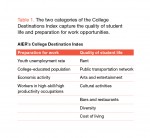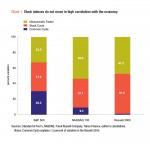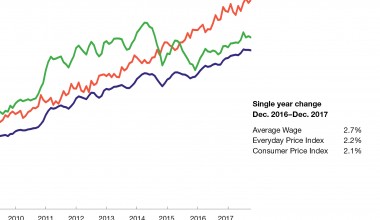Top College Destinations Offer a Full Life Off Campus
This year we rank San Francisco and Boston tops among major metros because of their high scores in both categories. Among midsize metros, San José, home of Silicon Valley, ranks first for the prep-for-work ecosystem, and New Orleans ranks first for the quality of student life. Among the small metros and the college towns, the top-ranked places house major universities—such as Ithaca, N.Y. (Cornell University, Ithaca College), Corvallis, Ore. (Oregon State University), Madison, Wis. (University of Wisconsin), Durham (Duke University), and Chapel Hill, N.C. (University of North Carolina).
Major metros
San Francisco and Boston rank first and second of all major metropolitan areas. Of the 15 regions in our study with over 2.5 million residents, these cities score very high on both the preparation-for-work and the quality-of- student-life categories of our index. In the prep-for-work category we are capturing the work ecosystem that college students face. Does the metropolitan area’s economic environment offer students possibilities for work in the nation’s growth industries? Does the local economy provide employment opportunities for young people? Is the workforce employed in high-skill/high-productivity occupations? Both of these coastal metropolitan areas score high on prep-for-work.
Our index uses seven measures to capture the quality of student life. San Francisco and Boston both came up with top scores despite their very high rents. Strength in the areas of quality of student life — extensive public transportation networks; vibrant arts, culture, and entertainment scenes; and racial and ethnic diversity—all contribute to opportunities for socializing outside of school and work.
Seattle and Denver rank third and fourth, respectively, among our Top 15 Major Metro areas. The natural beauty in both of these metros was part of the allure for a young, well-educated population who moved to the Rockies and Pacific Northwest in the 1980s and 1990s to make their mark in new technology industries. Both of these western cities benefited when new technologies made remote collaboration possible, allowing entrepreneurs to set up high-tech operations outside of the immediate orbit of Silicon Valley in California and Route 128 in Massachusetts. Today, strength in the economy and a robust arts and cultural scene push Seattle into its third-place rank. Denver’s fourth-place rank owes to a strong economy, an appealing cultural scene, rents that are about average for major metros, and prices that are significantly below average for this group of cities.
Top 10 major metro rankings
1. San Francisco
2. Boston
3. Seattle
4. Denver
5. Houston
6. Minneapolis
7. Washington, DC
8. Dallas
9. San Diego
10. New York City
It’s not surprising that San Francisco or Boston both rank high on quality of student life and preparation for work. A few major metros achieved high rankings despite wide variations between these two parts of the index. Denver, Washington, D.C., and Minneapolis all achieved their rankings with outsize showings in the measures that indicate a fertile work ecosystem. Top rankings in New York City, Los Angeles, and St. Louis were earned because measures that capture their quality of life far outpace the prep-for-work attributes. The other cities in this group are more evenly balanced in their work ecosystem and quality of life.
Midsize metros
The cities in the midsize group include centers for regional industrial growth, such as Salt Lake City, Utah, and Pittsburgh, Pa., and state capitals such as Austin, Texas; Raleigh, N.C.; Columbus, Ohio; Indianapolis, Ind.; Richmond, Va.; Sacramento, Calif.; and Nashville, Tenn. Some of these midsize metros also serve as national hubs for economic niches, such as Nashville’s role in the music industry or San José’s centrality to Silicon Valley and the nation’s high-tech industry.
Top 10 midsize metro rankings
1. San José, Calif.
2. Austin, Texas
3. Pittsburgh, Pa.
4. Raleigh, N.C.
5. Salt Lake City, Utah
6. Portland, Ore.
7. Nashville, Tenn.
8. Columbus, Ohio
9. Grand Rapids, Mich.
10. Milwaukee, Wis.
1. San José, Calif.
2. Austin, Texas
3. Pittsburgh, Pa.
4. Raleigh, N.C.
5. Salt Lake City, Utah
6. Portland, Ore.
7. Nashville, Tenn.
8. Columbus, Ohio
9. Grand Rapids, Mich.
10. Milwaukee, Wis.
Among the 31 midsize metros—areas with one million to 2.5 million residents—the contribution of the work ecosystem is greatest in San José, as is the spread between the prep-for-work measures and the quality of student life (see Chart 1). Despite this spread San José still ranks at the top of the midsize pack. In contrast, New Orleans ranks 13th among all the midsize metro areas, but the spread between its work and student-life components is greatest in its class among cities where the quality of student life out-ranks the prep-for-work measures.
When we look under the hood of the quality-of-student-life measure for just San José and New Orleans, we can see the great variation in economic conditions across metro areas, even between those in the same population class. High costs—both in terms of rent and other goods and services – can account for a low student-life score in San José and a high score in New Orleans. Certainly this isn’t a surprise, since San José, like the rest of the Bay Area and much of the State of California, suffers from high housing costs. Not surprisingly, arts, culture and entertainment, and bars and restaurants make an outsize contribution to New Orleans’s high student quality-of-life score. The contrast with the paltry presence of arts and culture in San José is striking indeed.
Other metros in the midsize category that score near the top are places with a reputation for high-tech innovation. Second-place Austin has a growing start-up tech sector, fostered by activity at the University of Texas’s flagship campus. While the public university plays an important role in supporting the strength in the private economy, private investment has been prominent in the area more recently, as seen in Austin’s share of venture capital, which was 30 percent above the national average in 2012.
Small Metros
The small metro category captures regions that are home to 250,000 to one million residents; 133 such cities are in our study. While the top ranks include a range of cities representing all parts of the country, the list is striking for the number that depend on a university or a cluster of universities for shaping their regional economy (Table 2). We all know that the commercial strip in most college towns was once lined with used record and bookstores and locally owned cafés that offered bottomless 25-cent cups of coffee that have given way to Starbucks and the Apple Store. While colleges and universities have long shaped the cultural and intellectual life in their communities, they are now shaping economic life as well. The productive sector of these once-small college towns also has changed. This is true in places like Durham, N.C., and nearby Chapel Hill, N.C., as well as Ann Arbor, Mich., and Madison, Wis. An important part of this transformation is research licensing and partnerships, in which university-based researchers work in labs and commercial ventures outside the campus walls.
Top 10 small metro rankings
1. Boulder, Colo.
2. Durham, N.C.
3. Ann Arbor, Mich.
4. Madison, Wis.
5. Fort Collins, Colo.
6. Santa Barbara, Calif.
7. Provo, Utah
8. Naples, Fla.
9. Trenton, N.J.
10. Huntsville, Ala.
1. Boulder, Colo.
2. Durham, N.C.
3. Ann Arbor, Mich.
4. Madison, Wis.
5. Fort Collins, Colo.
6. Santa Barbara, Calif.
7. Provo, Utah
8. Naples, Fla.
9. Trenton, N.J.
10. Huntsville, Ala.
With universities serving as economic and cultural anchors in these cities, all but one of these small metro areas ranks high on the quality-of-student-life measures. We were not surprised to find that our measures did not pick up a high concentration of bars in Provo, Utah, the metro area that is home to Brigham Young University. What Provo lacks in mainstream measures of quality- of-student life, it makes up for in its strong showing on prep-for-work, with a top score in youth employment, a highly educated workforce, many high-tech/high productivity workers, and a growing economy.
Higher education is important in the small metros, even beyond the anchor role that universities play in the local economy. Seven of the 10 small metros that rank highest for educational attainment for the population as a whole are also in our top 10 in this category. Furthermore, retirement haven Myrtle Beach, S.C., was alone among the top 20 small metros that did not have a high ranking on the individual measure of educational attainment.
Towns
What is striking about our towns—urban places with fewer than 250,000 people—is how universities are so central to the economic and cultural life of the top-ranked areas. The list of universities among the top-ranked towns is also notable for the number of land-grant institutions—colleges that received federal grants of land in the 19th century to offer technological, agricultural, and other practical educational offerings to working people. Of the 10 towns in our study that rank highest for employment in the STEM fields (science, technology, engineering, and math) six are home to land-grant institutions (Table 3).
While universities can propel a local economy, medical centers can also serve as a local economic driver. Like universities, medical centers employ highly trained workers who can command good wages. Rochester, Minn., home of several colleges and the Mayo Clinic, is among the towns with a high concentration of STEM workers. Students with an interest in STEM fields will be interested in exploring towns that are home to the “eds and meds.” With high-skilled workers and institutions that are anchored in place (not often subject to relocation due to the search for lower cost production sites) these towns provide good opportunities to prepare for the world of work.
While Ames, Iowa, scored second among towns in the share of employment dedicated to the STEM fields, it also is well balanced on both aspects of our index, with a fourth-place ranking on the quality of student life. Santa Fe, N.M., topped our town rankings for the quality of student life. It has been named a UNESCO Creative City in Design, Crafts, and Folk Art, which provides a strong grounding for its cultural offerings. In addition, we found Santa Fe to have relatively lower costs than many of its counterparts, which means that students interested in the arts will find plenty of opportunity in New Mexico, the Land of Enchantment.
Top 10 college towns
1. Ames, Iowa
2. Ithaca, N.Y.
3. Iowa City, Iowa
4. Charlottesville, Va.
5. Columbia, Mo.
6. Santa Fe, N.M.
7. Corvallis, Ore.
8. Missoula, Mont.
9. Fargo, N.D.
10. Lafayette, Ind.
Among our other findings in the 2015 CDI
The four top metros in their size category for public transportation and accessibility are New York City (major), Portland, Ore. (midsize), Boulder, Colo. (small), and Ithaca, N.Y. (town). While New York City’s extensive subway system is well known, students may be surprised to learn that Boulder has a massive network of walking paths and trails, more than 300 miles of bike lanes and paths, and a fleet of buses named for Hop, Skip, Jump, Bound, Dash, Stampede, and Bolt routes, along with late night transit.
The four top metros in their size category for public transportation and accessibility are New York City (major), Portland, Ore. (midsize), Boulder, Colo. (small), and Ithaca, N.Y. (town). While New York City’s extensive subway system is well known, students may be surprised to learn that Boulder has a massive network of walking paths and trails, more than 300 miles of bike lanes and paths, and a fleet of buses named for Hop, Skip, Jump, Bound, Dash, Stampede, and Bolt routes, along with late night transit.
Washington, D.C., tops the list of major metros employing STEM workers, with employers as diverse as defense contractor Northrup Grumman and the National Institutes of Health. Other top STEM spots are San José, Calif. (midsize), Huntsville, Ala. (small metro), and Corvallis, Ore. (town). Huntsville, home of a NASA flight center, is known as “The Rocket City” for research in rocket propulsion and for a high concentration of aerospace and military technology firms. Major employers in Corvallis, aside from Oregon State University, are biopharm, health, and technology companies. Corvallis hosts an annual Da Vinci Days festival to celebrate science, technology, and art.
Our lowest cost-of-living cities (aside from rent, which we ranked separately) are St. Louis, Mo. (major metro), Cincinnati, Ohio (midsize), Asheville, N.C. (small), and Manhattan, Kan. (town). Asheville is the home of the Frugal Backpacker, specializing in closeouts and vendor samples so that you can hike the Blue Ridge Mountains in affordable style. Manhattan, Kan. (“The Little Apple”) is the home of Kansas State University and what must be a unique cultural experience – the K-State Insect Zoo, admission only $2.
Low unemployment for youth gained top rankings for Minneapolis (major metro), Grand Rapids, Mich., (midsize), Provo, Utah (small) and Columbia, Mo. (college town). CoMo, as Columbia is called, is home of the University of Missouri, or Mizzou, where you can catch a Tiger on game day (Mizzou-Rah). The university and its health center are the biggest employers in town.
Our arts and entertainment rankings are topped by Los Angeles (major metro), Nashville, Tenn. (midsize), Boulder, Colo. (small), and Santa Fe, N.M. (town). Students can visit The Broad museum of contemporary art in LA or check out the live music scene at The Station Inn or Tootsie’s Orchid Lounge in Nashville – Music City, U.S.A.
Detailed rankings are found at www.aier.org/cdi
[pdf-embedder url=”https://www.aier.org/wp-content/uploads/2015/11/interactiveIB_November_2015_CDI.pdf“]








